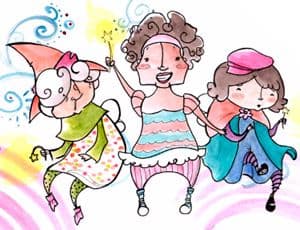Teacher's support sheet

The Clumsy Fairies
When a princess is born, the kingdom rejoices.
Everyone wants to meet her: nobles, artisans, fairies and even witches.
Princess Aurora was unlucky, right on the first day, she received several strange gifts!
Are you curious to know what happened? Read the story and be enchanted by this world of magic!
A retelling of "Sleeping Beauty".

Teacher’s tips
Level of education: Elementary School - Early Childhood Education
Age: 05 to 08 years
Nursery rhymes use repetitive patterns and structures, so kids start learning simple math skills as they recite them. Many rhymes also use numbers, counting, and other math words that kids need to learn, like size and weight.
Research has shown that rhyme awareness and the ability to sing songs and rhymes positively support children's language development and early literacy and reading skills.
Learner outcomes
Develop phonemic awareness; Build memory and articulation; Develop text reading and interpretation; Understand the use of the alphabet in the construction of words; Expand vocabulary; Stimulate the imagination; Stimulate creativity; Participate in different moments of reading; Develop attentive listening to understand texts; Develop and improve oral and written language; Read different types of short stories;
Teachers’ goals
Work on reading and text interpretation skills; Provide, in a playful and creative way, the progress in the reading and writing process of children; Expand the class's repertoire of letters and words; Offer the game as a didactic resource to fix the content worked in the classroom; Awaken the habit of listening and feeling pleasure in situations involving reading; Provide contact with texts of literary quality;
Suggestions of approaches for the teacher
(Suggestion 1) Do the readings of other verses and rhymes.
(Suggestion 2) Work with children's songs by asking and pointing to the rhymes.
(Suggestion 3) Ask the children to draw a picture on the book.
(Suggestion 4) Read the traditional story of Sleeping Beauty.
(Suggestion 5) Ask the children to compare the differences and similarities of the two stories.
(Suggestion 6) Set up a theater retelling the stories heard and read).
(Suggestion 7) Ask the students of the 2nd student to copy the unknown words in the notebook and later look up their meaning in the dictionary.
More about it
Benefits of teaching nursery rhymes to children
Develops phonemic awareness
Building memory and articulation
Promotes understanding of concepts: painting pictures in children's heads
Promotes the development of social routines
Provides new listening skills
Here are 8 ways parents and teachers can help their children learn nursery rhymes:
Identify and continue singing children's favorite lullabies. Children love repetition, which can help them learn better too.
Sing along with your child and clap/play along to the beat.
Use items around the house to make music and sing lullabies to increase the fun element.
Use actions to accompany words. Linking hand gestures and other actions with your body not only helps the child visualize the words, but it also makes it easier for the child to learn the lullaby.
Forget the words of the lullaby and ask the children to help fill in the missing words. This is a fun way to help children use their memory to recite the rhyme.
Remind them of the rhymes they have learned. Have them draw or paint. Use daily activities (counting etc).
Introduce new rhymes periodically for children. It helps to constantly engage your interest in learning.
Select rhymes that teach concepts like numbers, colors, shapes, weather, etc. to increase children's love of learning.
